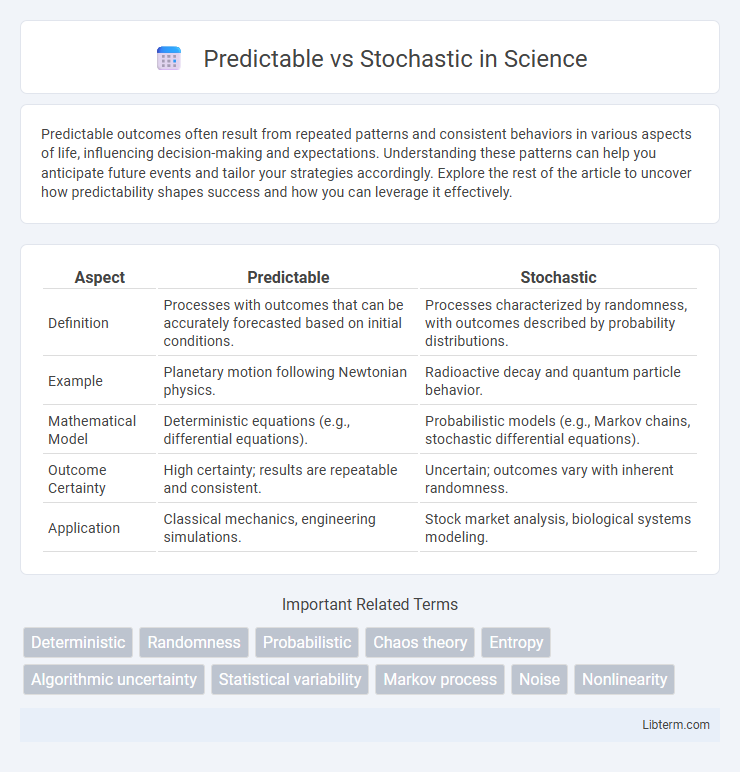Predictable outcomes often result from repeated patterns and consistent behaviors in various aspects of life, influencing decision-making and expectations. Understanding these patterns can help you anticipate future events and tailor your strategies accordingly. Explore the rest of the article to uncover how predictability shapes success and how you can leverage it effectively.
Table of Comparison
| Aspect | Predictable | Stochastic |
|---|---|---|
| Definition | Processes with outcomes that can be accurately forecasted based on initial conditions. | Processes characterized by randomness, with outcomes described by probability distributions. |
| Example | Planetary motion following Newtonian physics. | Radioactive decay and quantum particle behavior. |
| Mathematical Model | Deterministic equations (e.g., differential equations). | Probabilistic models (e.g., Markov chains, stochastic differential equations). |
| Outcome Certainty | High certainty; results are repeatable and consistent. | Uncertain; outcomes vary with inherent randomness. |
| Application | Classical mechanics, engineering simulations. | Stock market analysis, biological systems modeling. |
Introduction to Predictable and Stochastic Concepts
Predictable systems operate under deterministic rules, allowing future states to be forecasted with high accuracy based on initial conditions. Stochastic systems incorporate randomness and probabilistic elements, making their future behavior inherently uncertain and modeled through statistical methods. Understanding the contrast between these concepts is essential in fields such as physics, finance, and engineering, where accurate modeling of system dynamics impacts decision-making and risk assessment.
Defining Predictable Processes
Predictable processes are characterized by consistent and repeatable patterns where outcomes can be anticipated with high accuracy due to deterministic variables. These systems rely on known inputs and established relationships, allowing precise forecasting and control over future states. Understanding predictable processes enables efficient planning and optimization in fields such as manufacturing, finance, and project management.
Understanding Stochastic Processes
Stochastic processes describe systems that evolve with inherent randomness, making their future states unpredictable despite probabilistic patterns. Unlike predictable processes governed by deterministic rules, stochastic models rely on probability distributions to characterize uncertainty over time. Mastering stochastic processes is crucial for applications in finance, physics, and biology where randomness influences dynamic behavior.
Key Differences Between Predictable and Stochastic Systems
Predictable systems operate under deterministic rules, allowing future states to be forecasted with high accuracy based on initial conditions and known inputs. Stochastic systems involve inherent randomness, making outcomes probabilistic and less certain due to random variables and noise influences. Key differences include the degree of uncertainty, where predictable systems exhibit low variability, while stochastic systems require statistical methods to model their behavior.
Real-World Examples of Predictable Systems
Predictable systems operate with consistent patterns and repeatable outcomes, such as the planetary orbits governed by Newtonian physics and the regulated flow of electricity in power grids. Weather forecasting models, despite inherent uncertainties, can accurately predict short-term atmospheric conditions due to stable physical laws and extensive historical data. Manufacturing assembly lines exemplify predictability through standardized processes and automation, enabling precise control over production outputs.
Real-World Applications of Stochastic Models
Stochastic models excel in real-world applications where uncertainty and variability are inherent, such as financial markets, weather forecasting, and population dynamics. These models incorporate randomness to predict a range of possible outcomes, providing valuable insights for risk assessment and decision-making. By contrast, predictable models assume deterministic behavior, making them less effective for complex systems influenced by unpredictable factors.
Importance of Predictability in Risk Management
Predictability plays a crucial role in risk management by enabling more accurate forecasting and effective mitigation strategies for potential risks. Predictable risks allow organizations to allocate resources efficiently and implement control measures before adverse events occur, reducing uncertainty. In contrast, stochastic risks, characterized by randomness and unpredictability, necessitate flexible frameworks and contingency planning to address unexpected variations.
Stochastic Methods in Data Analysis
Stochastic methods in data analysis incorporate randomness and probabilistic models to handle uncertainty and variability within complex datasets. Techniques such as Monte Carlo simulations, Markov chains, and Bayesian inference allow analysts to model and predict outcomes where deterministic approaches fall short. These methods enhance decision-making processes by providing probabilistic estimates and capturing the inherent unpredictability in real-world data.
Challenges in Predicting Stochastic Events
Predicting stochastic events presents significant challenges due to their inherent randomness and dependence on probabilistic models rather than deterministic rules. Unlike predictable events governed by fixed patterns, stochastic processes require complex statistical analysis, often complicated by incomplete data and unpredictable external influences. These uncertainties make precise forecasting difficult, necessitating the use of sophisticated algorithms and continuous model refinement to improve accuracy.
Choosing Between Predictable and Stochastic Approaches
Choosing between predictable and stochastic approaches depends on the nature of the data and the problem domain. Predictable methods excel in environments with stable, deterministic patterns, offering reliability and consistency in outcomes. Stochastic approaches are preferred when dealing with uncertainty, variability, and complex systems, as they incorporate randomness to model and adapt to unpredictable factors effectively.
Predictable Infographic

 libterm.com
libterm.com